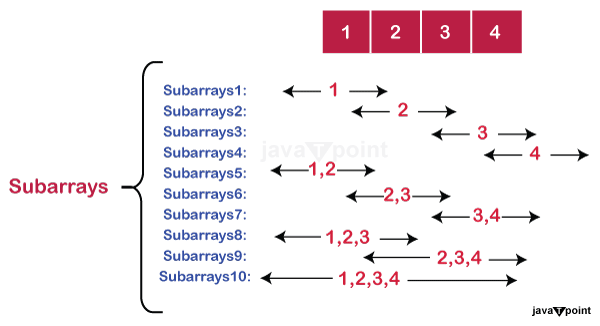Generate All SubarraysIntroduction:A fundamental programming and computer science technique, the idea of producing all subarrays has applications in many areas, including data analysis, algorithms, and problem-solving. Contiguous sections of an array are known as subarrays, and it is feasible to generate all conceivable subarrays in a variety of ways, each with specific benefits and applications. The importance of creating all subarrays will be examined, several strategies for doing so will be covered, and their practical applications will be highlighted in this article. 
Significance of Generating All Subarrays:
Understanding the structure and behavior of data requires the creation of all subarrays. It enables programmers to understand the distribution of the data, spot trends, and make wise judgments. Trends, anomalies, or correlations in the data can be found by looking at different subarrays, which is useful for data processing and analysis.
Subarrays play a key role in the operation of many algorithms. Programmers can create effective algorithms for jobs like searching, sorting, and pattern recognition by producing all subarrays. Understanding the characteristics and connections between subarrays can result in solutions that are optimized, requiring less effort and resources. Approaches to Generate All Subarrays:
A brute-force method is the quickest way to create every subarray of an array. This technique uses stacked loops to create subarrays by iterating through all potential starting and ending indices. Although this method is simple, it is inefficient for big arrays because of its O(n^3) time complexity.
When dealing with contiguous subarrays of a fixed size, the sliding window technique is a more effective way to generate subarrays. Maintaining and advancing a window with a predetermined length is required. This method is frequently used in algorithms like the maximum subarray sum issue and has an O(n) time complexity.
Dynamic programming techniques can also be used to efficiently generate every subarray. Dynamic programming can reduce time complexity by avoiding unnecessary calculations by building on previously computed subarrays. Kadane's algorithm, for instance, uses dynamic programming to calculate the greatest subarray sum. Practical Applications:
Challenges and Considerations:
Conclusion:A key method used in computer science is the generation of all subarrays, which provides useful data insights, makes it possible to create effective algorithms, and finds use in a variety of fields. The importance of producing subarrays resides in their capacity to highlight patterns, deconstruct challenging issues, and enhance solutions. When employing this technique, programmers should be aware of the many options and take into account their potential practical uses, computational complexity, and memory utilization. The capacity to construct all subarrays remains a potent tool in the programmer's toolbox in a world driven by data and algorithms.
Next TopicHeap memory vs. stack memory
|
 For Videos Join Our Youtube Channel: Join Now
For Videos Join Our Youtube Channel: Join Now
Feedback
- Send your Feedback to [email protected]
Help Others, Please Share









